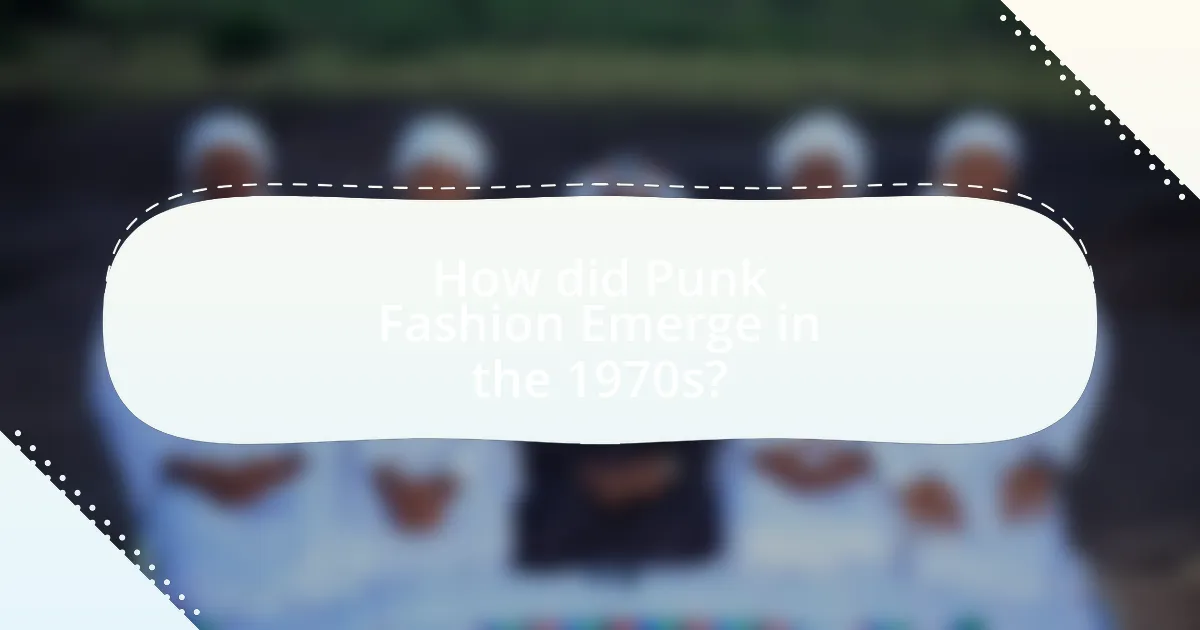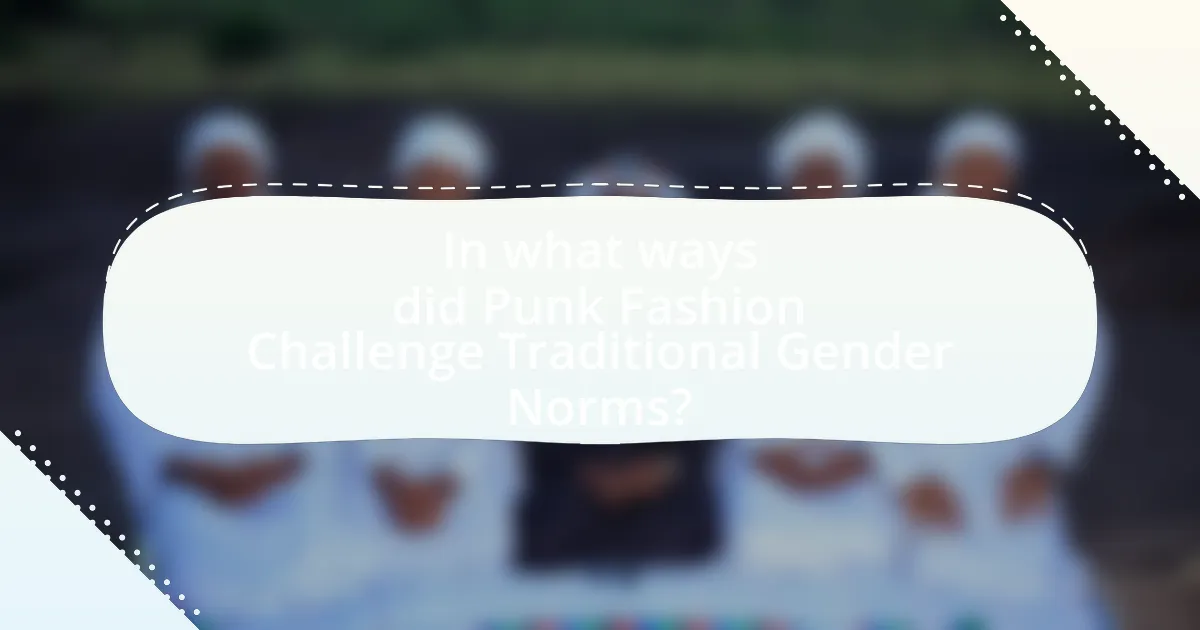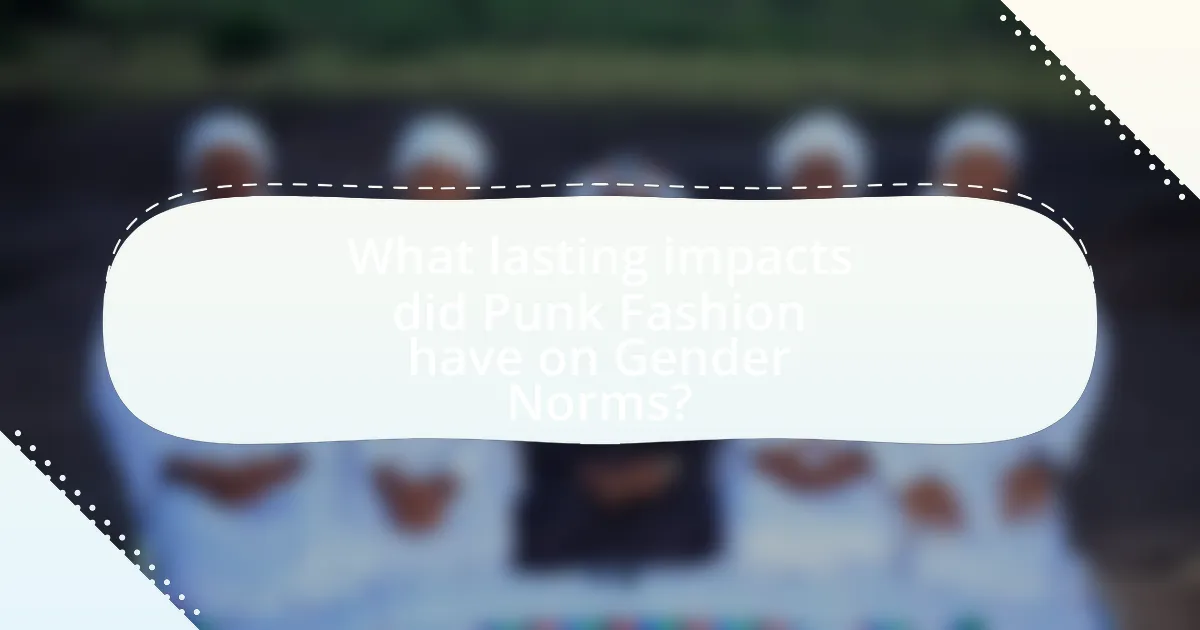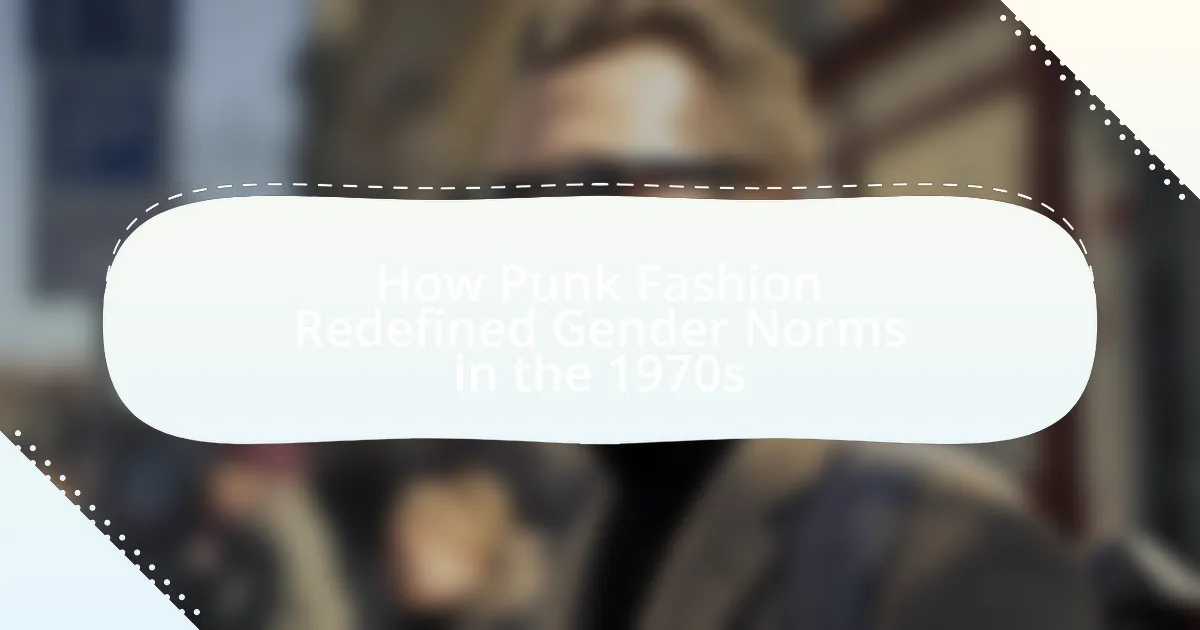Punk fashion emerged in the 1970s as a rebellious response to mainstream culture, characterized by a DIY aesthetic and anti-establishment ethos. Influenced by the punk music scene and countercultural movements, it featured key elements such as ripped clothing, leather jackets, and bold hairstyles, challenging traditional gender norms and promoting androgyny. The socio-political climate of the time, marked by economic instability and social upheaval, further shaped this movement, allowing individuals to express their identities freely. Influential figures like Vivienne Westwood played a crucial role in popularizing punk fashion, which not only redefined masculinity and femininity but also laid the groundwork for future discussions on gender fluidity and inclusivity in fashion.

How did Punk Fashion Emerge in the 1970s?
Punk fashion emerged in the 1970s as a rebellious response to mainstream culture, characterized by its DIY aesthetic and anti-establishment ethos. This movement was largely influenced by the punk music scene, particularly bands like the Sex Pistols and The Ramones, who rejected conventional styles and embraced a raw, edgy look. Key elements of punk fashion included ripped clothing, leather jackets, safety pins, and bold hairstyles, which collectively symbolized a rejection of societal norms and a challenge to traditional gender roles. The emergence of punk fashion was also fueled by influential designers such as Vivienne Westwood, who played a crucial role in popularizing the style through her boutique, SEX, in London. This convergence of music, fashion, and social commentary solidified punk as a significant cultural movement that redefined gender norms by allowing individuals to express their identities freely and subversively.
What cultural movements influenced the rise of Punk Fashion?
Punk fashion was influenced primarily by the countercultural movements of the 1960s and 1970s, including the Beat Generation, the Hippie movement, and the Anti-Establishment protests. The Beat Generation challenged societal norms through literature and art, promoting individualism and nonconformity, which laid the groundwork for punk’s rebellious aesthetic. The Hippie movement’s emphasis on freedom of expression and anti-materialism also contributed to punk’s ethos, encouraging a DIY approach to fashion. Additionally, the Anti-Establishment protests against political and social injustices galvanized youth culture, fostering a sense of defiance that punk fashion embodied through its distinctive styles, such as ripped clothing, leather jackets, and bold hairstyles. These cultural movements collectively shaped punk fashion as a form of resistance against mainstream societal expectations and gender norms.
How did the socio-political climate of the 1970s shape Punk Fashion?
The socio-political climate of the 1970s significantly shaped Punk Fashion by reflecting the era’s anti-establishment sentiments and social upheaval. The rise of punk was a direct response to economic instability, political corruption, and social inequality, particularly in the UK, where high unemployment and disillusionment with the government fueled a rebellious youth culture. Punk fashion, characterized by its DIY aesthetic, often included elements like ripped clothing, safety pins, and bold hairstyles, which symbolized defiance against mainstream norms and traditional gender roles. This fashion movement was further influenced by the feminist movement, which challenged conventional gender expectations, allowing for a more fluid expression of identity. The punk scene embraced androgyny, rejecting the binary notions of masculinity and femininity, thus redefining gender norms during this transformative decade.
What role did music play in the development of Punk Fashion?
Music was central to the development of Punk Fashion, serving as both inspiration and a means of expression for the punk subculture. The aggressive sounds and anti-establishment lyrics of bands like the Sex Pistols and The Clash influenced the visual aesthetics of punk, leading to the adoption of styles characterized by torn clothing, leather jackets, and bold hairstyles. This fashion was a direct reflection of the music’s themes of rebellion and nonconformity, with punk musicians often embodying the very styles they promoted. The synergy between punk music and fashion not only defined the look of the movement but also challenged traditional gender norms, as both men and women adopted androgynous styles that defied societal expectations of appearance in the 1970s.
What were the key characteristics of Punk Fashion?
Punk fashion is characterized by its rebellious and anti-establishment aesthetic, which includes elements such as leather jackets, ripped clothing, band t-shirts, and distinctive hairstyles like mohawks and brightly colored spikes. This style emerged in the 1970s as a reaction against mainstream fashion and societal norms, often incorporating DIY elements and accessories like safety pins and studs. The punk movement’s emphasis on individuality and self-expression challenged traditional gender norms, allowing for a fluidity in gender presentation that was revolutionary for its time.
How did DIY aesthetics manifest in Punk Fashion?
DIY aesthetics manifested in Punk Fashion through the use of handmade, customized clothing and accessories that rejected mainstream fashion norms. Punk subculture emphasized individual expression, leading to the creation of unique garments often adorned with safety pins, patches, and graffiti-style art. This approach was a direct response to the commercialization of fashion, as punks sought to assert their identity and challenge societal expectations. Historical evidence shows that influential punk bands and figures, such as the Sex Pistols and Vivienne Westwood, popularized this aesthetic, encouraging fans to create their own styles rather than conforming to traditional gender norms and fashion standards of the 1970s.
What materials and styles were commonly used in Punk Fashion?
Punk fashion commonly utilized materials such as leather, denim, and cotton, characterized by styles that included ripped clothing, safety pins, and graphic T-shirts. Leather jackets became iconic, often adorned with studs and patches, while distressed denim was frequently worn as a statement against mainstream fashion. The use of bold colors, unconventional hairstyles, and accessories like chains and spikes further defined the punk aesthetic, reflecting a rebellious attitude against societal norms. This fashion movement emerged in the 1970s, aligning with the punk rock music scene, which emphasized individuality and anti-establishment sentiments.

In what ways did Punk Fashion Challenge Traditional Gender Norms?
Punk fashion challenged traditional gender norms by promoting androgyny and rejecting conventional styles associated with masculinity and femininity. This movement encouraged individuals to express their identities through clothing that blurred gender lines, such as leather jackets, ripped jeans, and bold hairstyles, which were not confined to societal expectations. For instance, female punks often adopted styles that included masculine elements, such as suits or combat boots, while male punks embraced makeup and skirts, defying the rigid gender binary. The punk scene celebrated individuality and self-expression, as seen in the works of designers like Vivienne Westwood, who played a crucial role in shaping punk aesthetics that questioned and subverted traditional gender roles.
How did Punk Fashion redefine masculinity in the 1970s?
Punk fashion redefined masculinity in the 1970s by challenging traditional gender norms through its embrace of androgyny, rebellion, and self-expression. This movement encouraged men to adopt styles that included leather jackets, ripped clothing, and unconventional hairstyles, which contrasted sharply with the prevailing masculine ideals of the time that emphasized conformity and traditional masculinity. The punk subculture, represented by bands like the Sex Pistols and The Clash, promoted a do-it-yourself ethos that allowed men to express their individuality and reject societal expectations. This shift was significant as it opened up new avenues for male identity, allowing for a broader spectrum of gender expression and challenging the binary view of masculinity.
What specific clothing items symbolized a shift in masculine identity?
Specific clothing items that symbolized a shift in masculine identity during the punk fashion movement of the 1970s include leather jackets, skinny jeans, and combat boots. These items represented a departure from traditional masculine attire, embracing a more rebellious and androgynous aesthetic. The leather jacket, often adorned with studs and patches, became a symbol of defiance against societal norms, while skinny jeans challenged conventional ideas of masculinity by emphasizing body shape. Combat boots, associated with working-class culture, further reinforced the punk ethos of anti-establishment sentiment. Collectively, these clothing items marked a significant transformation in how masculinity was expressed and perceived during this era.
How did male punk icons influence perceptions of masculinity?
Male punk icons significantly influenced perceptions of masculinity by challenging traditional gender norms and promoting a more fluid understanding of male identity. Bands like the Sex Pistols and The Clash embodied a rebellious spirit that rejected conventional masculinity, emphasizing individuality and self-expression over stoicism and aggression. Their fashion choices, which included androgynous clothing, makeup, and unconventional hairstyles, further blurred the lines between masculine and feminine traits. This shift was evident in the punk movement’s embrace of vulnerability and emotional expression, contrasting sharply with the dominant ideals of masculinity in the 1970s. The impact of these icons is reflected in the broader cultural acceptance of diverse masculinities, paving the way for future generations to explore and redefine gender roles.
How did Punk Fashion empower women and redefine femininity?
Punk fashion empowered women and redefined femininity by promoting self-expression and challenging traditional gender norms. This movement encouraged women to adopt a rebellious aesthetic characterized by bold clothing choices, such as leather jackets, ripped jeans, and unconventional hairstyles, which contrasted sharply with the prevailing feminine ideals of the time. The punk scene provided a platform for women to assert their identities and reject societal expectations, as exemplified by influential figures like Vivienne Westwood and Debbie Harry, who embodied this defiance. The punk ethos celebrated individuality and strength, allowing women to embrace a more assertive and liberated version of femininity, ultimately reshaping cultural perceptions of gender roles in the 1970s.
What were the significant fashion choices that challenged traditional femininity?
Significant fashion choices that challenged traditional femininity in the 1970s included the adoption of androgynous styles, leather jackets, ripped clothing, and combat boots. These choices were emblematic of the punk movement, which rejected conventional gender norms and embraced a more rebellious, non-conformist aesthetic. For instance, women in punk culture often wore tailored suits or oversized clothing, which contrasted sharply with the traditionally feminine silhouettes of the time. The use of bold colors, safety pins, and DIY fashion further emphasized individuality and defiance against societal expectations. This shift was not just a fashion statement; it represented a broader cultural movement that sought to redefine gender roles and empower women to express themselves outside of traditional femininity.
How did female punk figures contribute to the feminist movement through fashion?
Female punk figures contributed to the feminist movement through fashion by challenging traditional gender norms and promoting self-expression. Icons like Vivienne Westwood and Debbie Harry utilized clothing as a means to subvert societal expectations, often incorporating elements that were considered provocative or androgynous. This defiance against conventional femininity not only empowered women to embrace their individuality but also sparked discussions about gender identity and equality. The punk aesthetic, characterized by leather jackets, ripped clothing, and bold hairstyles, became a visual representation of rebellion against patriarchal standards, thus aligning with feminist ideals of autonomy and liberation.

What lasting impacts did Punk Fashion have on Gender Norms?
Punk fashion significantly challenged and redefined traditional gender norms by promoting androgyny and self-expression. This movement encouraged individuals to reject conventional gender roles, as seen in the adoption of clothing styles that blurred the lines between masculine and feminine attire, such as leather jackets, ripped clothing, and bold hairstyles. The punk subculture’s emphasis on individuality and rebellion against societal expectations fostered a more inclusive understanding of gender identity, paving the way for future movements advocating for gender fluidity and LGBTQ+ rights. Historical examples include influential figures like David Bowie and Patti Smith, who embodied these ideals, demonstrating that fashion could serve as a powerful tool for challenging gender stereotypes and promoting equality.
How did Punk Fashion influence later fashion movements and gender expressions?
Punk fashion significantly influenced later fashion movements and gender expressions by challenging traditional norms and embracing individuality. This subculture, emerging in the 1970s, utilized bold aesthetics such as ripped clothing, leather jackets, and unconventional hairstyles to reject mainstream fashion and societal expectations. The punk movement’s emphasis on self-expression and anti-establishment attitudes paved the way for subsequent styles, including grunge and goth, which similarly embraced nonconformity.
Moreover, punk fashion blurred gender lines by promoting androgyny, allowing individuals to express their identities beyond binary norms. Designers like Vivienne Westwood and Jean-Paul Gaultier drew inspiration from punk’s rebellious spirit, incorporating elements of its aesthetic into high fashion, thus validating its impact on broader fashion trends. The punk movement’s legacy is evident in contemporary fashion, where gender fluidity and diverse expressions of identity are increasingly celebrated.
What elements of Punk Fashion can be seen in contemporary gender-fluid styles?
Contemporary gender-fluid styles incorporate elements of punk fashion such as androgynous silhouettes, bold colors, and DIY aesthetics. Androgynous silhouettes challenge traditional gender norms by blending masculine and feminine clothing, a hallmark of punk fashion that emerged in the 1970s. Bold colors and graphic prints, often associated with punk’s rebellious spirit, are prevalent in gender-fluid wardrobes, reflecting a desire for self-expression. Additionally, the DIY aesthetic, characterized by customized and often distressed clothing, remains influential, encouraging individuals to create unique styles that defy conventional gender categories. These elements collectively demonstrate how punk fashion has shaped modern gender-fluid expressions, promoting inclusivity and individuality.
How did the legacy of Punk Fashion affect societal views on gender identity?
The legacy of Punk Fashion significantly challenged and reshaped societal views on gender identity by promoting non-conformity and fluidity in gender expression. Punk culture, emerging in the 1970s, embraced a rejection of traditional gender norms through its aesthetic, which included androgynous clothing, bold hairstyles, and provocative accessories. This visual rebellion encouraged individuals to explore and express their gender identities beyond the binary framework, fostering a more inclusive understanding of gender.
For instance, figures like David Bowie and bands such as The Sex Pistols exemplified this shift by blurring gender lines, which resonated with audiences and inspired a generation to question established norms. The punk movement’s emphasis on individuality and self-expression laid the groundwork for later discussions on gender fluidity and LGBTQ+ rights, ultimately contributing to a broader societal acceptance of diverse gender identities.
What lessons can be learned from Punk Fashion’s approach to gender norms?
Punk Fashion’s approach to gender norms teaches the importance of challenging traditional gender roles and embracing individuality. By adopting styles that blurred the lines between masculinity and femininity, punk culture encouraged self-expression and defiance against societal expectations. For instance, the use of androgynous clothing, such as leather jackets and ripped jeans, allowed individuals to reject conventional gender identities. This movement was exemplified by figures like David Bowie and bands like The Sex Pistols, who utilized fashion as a form of rebellion. The punk scene’s emphasis on personal identity over societal norms has influenced contemporary discussions on gender fluidity and inclusivity, demonstrating that fashion can be a powerful tool for social change.
How can individuals express their identity through fashion today?
Individuals can express their identity through fashion today by choosing styles, colors, and accessories that reflect their personal beliefs, cultural backgrounds, and individual preferences. This expression is facilitated by the diverse range of fashion available, which allows for the blending of various influences, including punk aesthetics that challenge traditional gender norms. For instance, the punk movement of the 1970s introduced clothing that defied conventional gender roles, such as androgynous silhouettes and bold statements, which continue to inspire contemporary fashion choices. This historical context demonstrates how fashion serves as a medium for self-expression and identity formation, allowing individuals to communicate their uniqueness and social messages through their attire.
What are some best practices for embracing non-conformity in personal style?
To embrace non-conformity in personal style, individuals should prioritize authenticity by selecting clothing and accessories that genuinely reflect their personality and beliefs. This approach encourages self-expression and challenges societal norms, as seen in the punk fashion movement of the 1970s, which rejected mainstream aesthetics in favor of unique, often provocative styles. Historical evidence shows that punk fashion utilized DIY elements, such as customized garments and bold colors, to assert individuality and defy conventional gender norms. By adopting similar practices, such as mixing different styles, experimenting with unconventional materials, and incorporating personal symbols, individuals can effectively embrace non-conformity in their personal style.

Leave a Reply